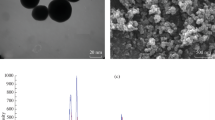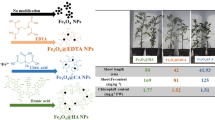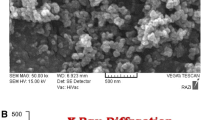Abstract
Iron deficiency has been becoming a worldwide problem in crop cultivation. New approaches are desired to alleviate the iron-deficit chlorosis. Iron-containing nanomaterials could be effective to supply the iron to plants and promote plant growth. In this study, soil cultured watermelon plants were treated with 100, 200, and 400 ppm α- and γ-Fe2O3 nanoparticles (NPs), respectively. Growth and physiology parameters were investigated in a period of time. The study also evaluated the nutritional quality of watermelon fruit. Results showed that no elevation of plant growth or chlorophyll content was observed. All α- and γ-Fe2O3 NPs treatments had no positive influence on nutritional components including central and edge sugar content, and total amino acid content. An interesting result was that the vitamin C (VC) content of all NP treatments was significantly improved compared with the control group (without iron). In addition, we found that iron distribution of α- and γ-Fe2O3 NPs treatments was closely related to the concentrations of NPs. Both α- and γ-Fe2O3 NPs could accumulate in root, stem, and leaf of watermelon plants, but only 400 ppm γ-Fe2O3 NPs treatment was found to exist in watermelon fruit. Although no promotion of α- and γ-Fe2O3 NPs on the growth of watermelon plants was occurred, our results showed that both α- and γ-Fe2O3 NPs could enter plant roots and translocate upwards to other tissues. Our finds will provide data for the future applications of iron-containing nanomaterials in agricultural production.

Graphical Abstract




Similar content being viewed by others
References
Abadía, J., Morales, F., & Abadía, A. (1999). Photosystem II efficiency in low chlorophyll, iron-deficient leaves. Plant and Soil. https://doi.org/10.1023/A:1004451728237.
Aksoy, E., Maqbool, A., Tindas, İ., & Caliskan, S. (2017). Soybean: A new frontier in understanding the iron deficiency tolerance mechanisms in plants. Plant and Soil. https://doi.org/10.1007/s11104-016-3157-x.
Alidoust, D., & Isoda, A. (2014). Phytotoxicity assessment of γ-Fe2O3 nanoparticles on root elongation and growth of rice plant. Environment and Earth Science. https://doi.org/10.1007/s12665-013-2920-z.
Alscher, R. G., Erturk, N., & Heath, L. S. (2002). Role of superoxide dismutases (SODs) in controlling oxidative stress in plants. Journal of Experimental Botany. https://doi.org/10.1093/jxb/53.372.1331.
Asoufi, H. M., Al-Antary, T. M., & Awwad, A. M. (2018). Green route for synthesis hematite (α-Fe2O3) nanoparticles: Toxicity effect on the green peach aphid, Myzus persicae (Sulzer). Environmental Nanotechnology, Monitoring and Management. https://doi.org/10.1016/j.enmm.2018.01.004.
Briat, J. F., Dubos, C., & Gaymard, F. (2015). Iron nutrition, biomass production, and plant product quality. Trends in Plant Science. https://doi.org/10.1016/j.tplants.2014.07.005.
Curie, C., & Briat, J.-F. (2003). Phospholipid-based signaling in plants. Annual Review of Plant Biology. https://doi.org/10.1146/annurev.arplant.54.031902.135018.
Chen G., Yang, J., Liu, H., & Shen, S.(2010). Dynamic change of four physiological indices of the Penthorum chinense Pursh yellow seeding in the procedure of green-turning. Medicinal Plant.
Demir, V., Ates, M., Arslan, Z., Camas, M., Celik, F., Bogatu, C., & Can, Ş. S. (2015). Influence of alpha and gamma-iron oxide nanoparticles on marine microalgae species. Bulletin of Environmental Contamination and Toxicology. https://doi.org/10.1007/s00128-015-1633-2.
Dimkpa, C. O., McLean, J. E., Latta, D. E., Manangón, E., Britt, D. W., Johnson, W. P., et al. (2012). CuO and ZnO nanoparticles: Phytotoxicity, metal speciation, and induction of oxidative stress in sand-grown wheat. Journal of Nanoparticle Research. https://doi.org/10.1007/s11051-012-1125-9.
Gruère, G., Narrod, C., & Abbott, L. (2011). Agricultural, food, and water nanotechnologies for the poor: Opportunities, constraints, and role of the Consultative Group on International Agricultural Research. IFPRI Discussion Paper 01064
Gui, X., Deng, Y., Rui, Y., Gao, B., Luo, W., Chen, S., et al. (2015). Response difference of transgenic and conventional rice (Oryza sativa) to nanoparticles (γFe2O3). Environmental Science and Pollution Research. https://doi.org/10.1007/s11356-015-4976-7.
Habib, S. H., Kausar, H., & Saud, H. M. (2016). Plant growth-promoting Rhizobacteria enhance salinity stress tolerance in okra through ROS-scavenging enzymes. BioMed Research International. https://doi.org/10.1155/2016/6284547.
Hao, Y., Cao, X., Ma, C., Zhang, Z., Zhao, N., Ali, A., et al. (2017). Potential applications and antifungal activities of engineered nanomaterials against gray mold disease agent botrytis cinerea on rose petals. Frontiers in Plant Science. https://doi.org/10.3389/fpls.2017.01332.
Hu, J., Guo, H., Li, J., Gan, Q., Wang, Y., & Xing, B. (2017a). Comparative impacts of iron oxide nanoparticles and ferric ions on the growth of Citrus maxima. Environmental Pollution. https://doi.org/10.1016/j.envpol.2016.11.064.
Hu, J., Guo, H., Li, J., Wang, Y., Xiao, L., & Xing, B. (2017b). Interaction of γ-Fe2O3 nanoparticles with Citrus maxima leaves and the corresponding physiological effects via foliar application. Journal of Nanobiotechnology. https://doi.org/10.1186/s12951-017-0286-1.
Kastoori Ramamurthy, R., Jedlicka, J., Graef, G. L., & Waters, B. M. (2014). Identification of new QTLs for seed mineral, cysteine, and methionine concentrations in soybean [Glycine max (L.) Merr.]. Molecular Breeding. https://doi.org/10.1007/s11032-014-0045-z.
Lei, C., Zhang, L., Yang, K., Zhu, L., & Lin, D. (2016). Toxicity of iron-based nanoparticles to green algae: Effects of particle size, crystal phase, oxidation state and environmental aging. Environmental Pollution. https://doi.org/10.1016/j.envpol.2016.07.030.
Li, J., Hu, J., Ma, C., Wang, Y., Wu, C., Huang, J., & Xing, B. (2016). Uptake, translocation and physiological effects of magnetic iron oxide (γ-Fe2O3) nanoparticles in corn (Zea mays L.). Chemosphere. https://doi.org/10.1016/j.chemosphere.2016.05.083.
Li, J., Hu, J., Xiao, L., Wang, Y., & Wang, X. (2018). Interaction mechanisms between α-Fe 2 O 3 , γ-Fe 2 O 3 and Fe 3 O 4 nanoparticles and Citrus maxima seedlings. The Science of the Total Environment. https://doi.org/10.1016/j.scitotenv.2017.12.276.
Lichtenthaler, H. K. (1987). Chlorophylls and carotenoids: Pigments of photosynthetic biomembranes. Methods in Enzymology. https://doi.org/10.1016/0076-6879(87)48036-1.
Ma, X., Wang, Q., Rossi, L., Ebbs, S. D., & White, J. C. (2016). Multigenerational exposure to cerium oxide nanoparticles: Physiological and biochemical analysis reveals transmissible changes in rapid cycling Brassica rapa. NanoImpact. https://doi.org/10.1016/j.impact.2016.04.001.
Ma, Y., He, X., Zhang, P., Zhang, Z., Ding, Y., Zhang, J., et al. (2017). Xylem and phloem based transport of CeO2 nanoparticles in hydroponic cucumber plants. Environmental Science and Technology. https://doi.org/10.1021/acs.est.6b05998.
Manikandan, R., Sahi, S. V., & Venkatachalam, P. (2015). Impact assessment of mercury accumulation and biochemical and molecular response of Mentha arvensis: A potential hyperaccumulator plant. The Scientific World Journal. https://doi.org/10.1155/2015/715217.
Manzo, S., Rocco, A., Carotenuto, R., de Luca Picione, F., Miglietta, M. L., Rametta, G., & Di Francia, G. (2011). Investigation of ZnO nanoparticles’ ecotoxicological effects towards different soil organisms. Environmental Science and Pollution Research. https://doi.org/10.1007/s11356-010-0421-0.
Marusenko, Y., Shipp, J., Hamilton, G. A., Morgan, J. L. L., Keebaugh, M., Hill, H., et al. (2013). Bioavailability of nanoparticulate hematite to Arabidopsis thaliana. Environmental Pollution. https://doi.org/10.1016/j.envpol.2012.11.020.
Meloni, D. A., Oliva, M. A., Martinez, C. A., & Cambraia, J. (2003). Photosynthesis and activity of superoxide dismutase, peroxidase and glutathione reductase in cotton under salt stress. Environmental and Experimental Botany. https://doi.org/10.1016/S0098-8472(02)00058-8.
Nel, A., Xia, T., Mädler, L., & Li, N. (2006). Toxic potential of materials at the nanolevel. Science. https://doi.org/10.1126/science.1114397.
O’Carroll, D., Sleep, B., Krol, M., Boparai, H., & Kocur, C. (2013). Nanoscale zero valent iron and bimetallic particles for contaminated site remediation. Advances in Water Resources. https://doi.org/10.1016/j.advwatres.2012.02.005.
Palmqvist, N. G. M., Seisenbaeva, G. A., Svedlindh, P., & Kessler, V. G. (2017). Maghemite nanoparticles acts as nanozymes, improving growth and sbiotic stress tolerance in Brassica napus. Nanoscale Research Letters. https://doi.org/10.1186/s11671-017-2404-2.
Rao, S., & Shekhawat, G. S. (2016). Phytotoxicity and oxidative stress perspective of two selected nanoparticles in Brassica juncea. 3 Biotech. https://doi.org/10.1007/s13205-016-0550-3.
Rengel, Z., Batten, G. D., & Crowley, D. E. (1999). Agronomic approaches for improving the micronutrient density in edible portions of field crops. Field Crops Research. https://doi.org/10.1016/S0378-4290(98)00131-2.
Rico, C. M., Hong, J., Morales, M. I., Zhao, L., Barrios, A. C., Zhang, J. Y., et al. (2013). Effect of cerium oxide nanoparticles on rice: A study involving the antioxidant defense system and in vivo fluorescence imaging. Environmental Science & Technology. https://doi.org/10.1021/es401032m.
Rui, M., Ma, C., Hao, Y., Guo, J., Rui, Y., Tang, X., et al. (2016). Iron oxide nanoparticles as a potential iron fertilizer for peanut (Arachis hypogaea). Frontiers in Plant Science. https://doi.org/10.3389/fpls.2016.00815.
Sahoo, S. K., Parveen, S., & Panda, J. J. (2007). The present and future of nanotechnology in human health care. Nanomedicine: Nanotechnology, Biology, and Medicine. https://doi.org/10.1016/j.nano.2006.11.008.
Scartezzini, P., Antognoni, F., Raggi, M. A., Poli, F., & Sabbioni, C. (2006). Vitamin C content and antioxidant activity of the fruit and of the Ayurvedic preparation of Emblica officinalis Gaertn. Journal of Ethnopharmacology. https://doi.org/10.1016/j.jep.2005.08.065.
Schmedes, A., & Hølmer, G. (1989). A new thiobarbituric acid (TBA) method for determining free malondialdehyde (MDA) and hydroperoxides selectively as a measure of lipid peroxidation. Journal of the American Oil Chemists' Society. https://doi.org/10.1007/BF02653674.
Suresh, S., Karthikeyan, S., & Jayamoorthy, K. (2016). FTIR and multivariate analysis to study the effect of bulk and nano copper oxide on peanut plant leaves. Journal of Science: Advanced Materials and Devices. https://doi.org/10.1016/j.jsamd.2016.08.004.
Van Nhan, L., Ma, C., Rui, Y., Cao, W., Deng, Y., Liu, L., & Xing, B. (2016). The effects of Fe2O3 nanoparticles on physiology and insecticide activity in non-transgenic and Bt-transgenic cotton. Frontiers in Plant Science. https://doi.org/10.3389/fpls.2015.01263.
Venkatachalam, P., Jayaraj, M., Manikandan, R., Geetha, N., Rene, E. R., Sharma, N. C., & Sahi, S. V. (2017). Zinc oxide nanoparticles (ZnONPs) alleviate heavy metal-induced toxicity in Leucaena leucocephala seedlings: A physiochemical analysis. Plant Physiology and Biochemistry. https://doi.org/10.1016/j.plaphy.2016.08.022.
Wang, Y., Hu, J., Dai, Z., Li, J., & Huang, J. (2016). In vitro assessment of physiological changes of watermelon (Citrullus lanatus) upon iron oxide nanoparticles exposure. Plant Physiology and Biochemistry. https://doi.org/10.1016/j.plaphy.2016.08.003.
Wang, Z., Xie, X., Zhao, J., Liu, X., Feng, W., White, J. C., & Xing, B. (2012). Xylem- and phloem-based transport of CuO nanoparticles in maize (Zea mays L.). Environmental Science and Technology. https://doi.org/10.1021/es204212z.
Willekens, H., Chamnongpol, S., Davey, M., Schraudner, M., Langebartels, C., Van Montagu, M., et al. (1997). Catalase is a sink for H2O2 and is indispensable for stress defence in C3 plants. The EMBO Journal. https://doi.org/10.1093/emboj/16.16.4806.
Zhao, L., Peralta-Videa, J. R., Rico, C. M., Hernandez-Viezcas, J. A., Sun, Y., Niu, G., et al. (2014). CeO2 and ZnO nanoparticles change the nutritional qualities of cucumber (Cucumis sativus). Journal of Agricultural and Food Chemistry. https://doi.org/10.1021/jf405476u.
Funding
This work was supported by the National Key Research and Development Program of China (Grant Nos. 2018YFD0201300 and 2018YFD0100704); China Agriculture Research System (Grant No. CARS-25); and the Fundamental Research Funds for the Central Universities (Grant Nos. 2019IB005, 2018IB021, 2018IB023).
Author information
Authors and Affiliations
Contributions
Junli Li put forward the experimental idea and organized the experiment, and finally completed the manuscript. Fengting Wan, Jiali Huang, and Wenjing Guo completed most of the experiments and organized the manuscripts. Zhaoyi Dai and Licong Yi were responsible for field management, and Yunqiang Wang provided experimental materials and the experimental site in the field, as well as daily management. All authors contributed to the preparation of the final manuscript.
Corresponding authors
Ethics declarations
Conflict of Interest
The authors declare that they have no conflict of interest.
Additional information
Publisher’s Note
Springer Nature remains neutral with regard to jurisdictional claims in published maps and institutional affiliations.
Highlights
• Effects of α- and γ-Fe2O3 NPs on the whole growth period of watermelon were evaluated.
• γ-Fe2O3 NPs exhibited more phytotoxicity than α-Fe2O3 NPs.
• VC content of fruit was increased in all treatments.
Electronic supplementary material
ESM 1
(PDF 277 kb)
Rights and permissions
About this article
Cite this article
Li, J., Wan, F., Guo, W. et al. Influence of α- and γ-Fe2O3 Nanoparticles on Watermelon (Citrullus lanatus) Physiology and Fruit Quality. Water Air Soil Pollut 231, 143 (2020). https://doi.org/10.1007/s11270-020-04511-3
Received:
Accepted:
Published:
DOI: https://doi.org/10.1007/s11270-020-04511-3




